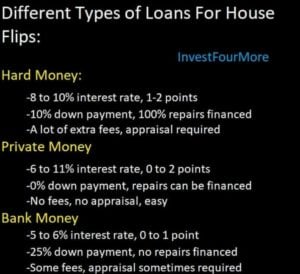
How Realistic Are House Flipping Television Shows?
 I flip a lot of houses (20 to 30 a year), and once in a while, I find myself watching a house-flipping show on television. In most cases, I get very frustrated because I know what they are producing is not realistic and nothing like flipping in the real world. Some might think house flipping shows are educational, but in many cases, I think the shows do more harm than good for people who are trying to learn about flipping.
I flip a lot of houses (20 to 30 a year), and once in a while, I find myself watching a house-flipping show on television. In most cases, I get very frustrated because I know what they are producing is not realistic and nothing like flipping in the real world. Some might think house flipping shows are educational, but in many cases, I think the shows do more harm than good for people who are trying to learn about flipping.
Some of the shows I enjoy, and some of the shows are a little over the top, but they all have one thing in common: television house flipping shows are a very bad portrayal of what it is really like to flip houses! Not only are they not accurate at portraying what it is like to flip houses, but they also teach some really bad lessons. I have interviewed myself for a few shows, but in the end, I was not chosen, which is probably a good thing considering I do not have a lot of spare time! In those interviews, I could tell exactly what they want for their flipping shows: a family team, someone who works on the houses, and someone who is willing to stretch the truth on what actually happens. But how realistic are house flipping television shows in the first place?
How much real-life information are we getting?
House flipping shows advertise themselves as an in-depth look at how the house flipping business works. However, television likes to show conflict and drama. There is plenty of drama and conflict when flipping and dealing with contractors. While we usually get a great look at the rehabbing process, which has the most drama, the flipping shows tend to leave out the most important part of flipping, which is finding awesome deals and financing them. I cannot blame the house flipping shows for producing what people want to watch, but most of the business is not shown or even discussed on these shows.
On some shows, I have my concerns that things are even faked to create more drama. Zombie House Flipping seemed to have a pipe break in every single episode!
What is the hardest thing about flipping houses?
I would agree with most of the house flipping shows when they say repairing houses is one of the hardest parts of the business. I have up to 22 flips going at once, and repairing that many properties is not easy! Finding the people to repair them is not easy either, but that is not the hardest part of flipping houses.
For someone looking to get started with flipping, there are two more important aspects to the business.
Finding the money to flip houses
It takes a lot of money to flip a house, and the house flipping shows tend to say nothing about that part of the business. If you purchase a $200,000 house to flip, here is a rough example of how much money you will need:
- Purchase price: $200,000
- Repairs: $50,000
- Carrying costs: $7,500
The repair costs and the purchase price are easy to figure out, but most shows leave out the carrying costs. Most people will be paying insurance, taxes, utilities, HOAs, yard maintenance, and more while they own the house. There will also be selling costs that we will talk about, but you most likely will not need to pay those out of pocket.
If you are buying this house with cash, you will need at least $260,000 to do the deal. Most people do not have $260,000 laying around to flip a house and will need to use financing. If you need a loan to flip the house, most banks will not lend to you. They find flipping too risky, so you may need to find private money or a hard-money lender. They will charge close to 10% for the money, which can add $10,000 to $15,000 to the costs.
Finding the house to flip
The other issue that many new flippers will find overwhelming is finding the deals that will work to flip. You need to buy houses incredibly cheap to make money. The days of going to the foreclosure sale and being the only bidder or buying bank-owned properties for pennies on the dollar are over. The shows imply that these deals are everywhere and just waiting for house flippers to make an offer. It takes an incredible amount of work to find deals good enough to flip.
Finding the money and finding the deal are the two most important aspects of house flipping, and the television shows give us almost no information on that part of the business.
Do house flippers get good deals on TV?
The original show, Flip or Flop, took place in Southern California. There are also other Flip or Flops in different markets of the country with different hosts. Housing prices are very high in California, but you can flip there if you have the cash and are willing to take some risks. Tarek and Christina are the stars of the show and are a husband and wife team. They are probably the most well-known house flippers because of their television show, although they got divorced and no longer produce it. I watched an episode recently, and they bought a $520,000 property which they planned to sell for $675,000. That leaves a ton of room, right? Let’s look at the numbers they give us:
- $520,000 purchase price
- $70,000 rehab budget
- $30,000 closing costs
- $620,000 total investment
- $55,000 profit potential!
They planned to make $55,000 on a $500,000 flip, which is crazy if you ask me. If anything goes wrong on a flip in that price range, your profit is gone. Many people like to use the 70 percent rule to get an idea if a house is worth flipping. The 70 percent rule states the purchase price on a flip should be 70 percent of the ARV (after repaired value) minus the repairs needed. For this house, the 70 percent rule states they should have bought it for:
$675,000 (Projected Sale Price) x .7 =$472,500. $472,500 – $70,000 (Repairs Needed) = $402,500.
While the 70 percent rule is not always the perfect way to judge a flip’s potential, it gives an idea of what most flippers pay. However, in higher price ranges, you can make money not using the 70 percent rule. I pay more than 70 percent in some cases, but I am also a real estate agent, which saves me money. Christina and Tarek are also agents, so they save money as well. If we go up to 75 percent of ARV minus repairs, they should have paid $436,250 for the house. They are paying about 87%!!!
This video also goes over house flipping shows:
Did they make any money?
They paid cash for the house and used their own cash for all the repairs. They went over budget on the repairs, mostly because they decided to spend $30,000 on landscaping. The contractors were very good and very fast. I have a really hard time on my own flips getting my contractors to work fast, and I was impressed with theirs. Of course, I do not know how many house flips they have going at once. I have 10 to 20 flips going most of the time.
According to HGTV, Tarek and Christina did make a profit on this home, even after going way over budget. After all was said and done, they ended up spending $124,600 on the remodel, but they were able to sell the home for $725,000. Here are the final numbers they gave us:
- $520,000 purchase price
- $124,600 repair cost
- $30,000 closing costs
- $725,000 selling price
- $39,000 profit!
A $39,000 profit on a house that sells for $725,000 is not a great profit margin! But, I don’t think they really made that much money either. The closing costs were low and they left out many other costs. First off, the real estate commission on one side of the sale would be around $21,000. Since they are real estate agents, they may not be paying a listing-side commission, which makes sense. After title insurance, closing fees, and other costs, they are pretty close with their $30,000 figure. You have to remember that if you are not a real estate agent, you will have much higher closing costs. They also left out these costs that most flippers will have:
- Carrying costs: while you own a flip, you must pay for utilities, potential HOA fees, insurance, taxes, and more. The carrying costs on a house in this price range would probably be at least $5,000 to $10,000.
- Buying costs: while the buying costs are usually minimal on most properties, you will have to pay part of the closing fee, sometimes title insurance, recording fees and more. Many times, investors pay for more items than usual in a purchase to entice the seller to sell to them at a great price. There was most likely at least a few thousand dollars in buying costs.
- Cost of money and labor: even if they pay cash for this property, that money could be used for other things. It is not free money as they portray it. They needed at least $645,000 in cash and probably took at least 5 months to complete the flip. If you made 5 percent interest on that money, you would make more than $13,000 in those five months. On these flips, Tarek and Christina are shown doing much of the manual labor. This could just be show for television, but if they are doing manual labor, they should not be working for free! I won’t count these costs, but they are something to consider.
If you were to add the $10,000 to $15,000 in extra costs that were not counted, the profit is less than $30,000, and that is from a sales price that was $50,000 higher than they first thought! That also does not consider the cost of labor or money that we ignored. These numbers show why they never should have bought this house in the first place. They were lucky to make anything. If you are wondering why they bought it, well…they have to flip houses to have a television show, and I am sure they make decent money from the show itself.
The good news is that they listed selling costs in their profit number. Most of the other shows I have seen do not list anything for selling costs, and I give Flip or Flop credit for trying to be more accurate on that front.
On the down side, they have both recently been sued for their involvement in house-flipping seminars.
Does Flipping Vegas give a more accurate portrayal of flipping houses?
Flipping Vegas is another house-flipping show. The star, Scott Yancy, has some awesome cars, and I am a car guy. Cool cars aside, the show is even less accurate than Flip or Flop. Here is a quick rundown of the show:
- They spend no time on telling us how they found the deals
- He uses multiple real estate agents to find him deals and sell houses
- The show is all about drama and Scott yelling at his contractors or wife, who is an interior designer
- He does a lot of the work himself as well
- They are not real estate agents as far as I can tell
On the episode I watched, he bought a house sight unseen through a real estate agent. I buy houses sight unseen, but they almost always have occupants in the house, but this house was vacant. When they get in the house, they see mold and water damage everywhere, even though the information they were given says all the issues were taken care of. If this happened in real life, you could definitely go after the seller for misrepresenting the condition of the home. If real estate agents are involved, there is even more opportunity to go after the agents who misrepresented the condition.
Here are the numbers they give us:
- $225,000 purchase price
- $20,000 estimated budget
- $305,000 sales price
- $60,000 potential profit
Do you notice anything wrong with these numbers? Maybe something that is missing, like closing costs, selling costs, carrying costs, or buying costs?
They find more mold than they thought, and they all have to wear full mold suits with respirators when they go into the house. I am now wondering how I am still alive after all the mold houses I have been in given the way they freaked out on the show. They figured on $10,000 to $15,000 more just for mold removal, which is a lot of money just to remove mold in my experience. After the rehab is done, the total bill comes to $45,000, and they get an offer for $349,000 for a profit of $79,000.
How are the numbers skewed on Flipping Vegas?
They left out a ton of costs on Flipping Vegas! Here is the short list:
- Selling costs: they had to use real estate agents to sell the house, which would have been around $25,000
- Carrying costs: they left out taxes, insurance, utilities, etc, which would have been $5,000
- Buying costs: I am assuming a couple thousand dollars for the house purchase
- Labor and cost of money: again, this was an all-cash purchase with no costs listed for financing or labor that Scott did himself.
After calculating the real costs on this flip, you see that he actually made less than $50,000, and that was on a price that was $44,000 higher than he first thought it would sell for. This was another deal that never should have been purchased and a huge misrepresentation of the profit. I watched a couple of other Flipping Vegas episodes, and they did the exact same thing. Most of the older flipping shows use similar figures that leave out many costs when flipping as well.
How much would financing cost on these properties?
Almost every house-flipping show leaves out costs associated with buying, holding, and selling the home. Flip or Flop does a better job than most but still instills some very risky tendencies. The biggest problem with the house-flipping shows is they assume all the flippers pay cash for their deals and have an unlimited amount of money. This is not realistic! I want to show an example of what it would cost me to flip a house like they flipped on television. I use a mix of bank and private money to finance my deals.
- $520,000 purchase price
- 75 percent financed
- 5.25 percent interest
- 1 percent origination fee
Total financing costs for six months would be $15,437 for me, and I have a great deal with my bank. That would also assume I put $130,000 down and pay for all the repairs out of my own pocket. If you used hard money, which is very common with flippers, the rates would be 8 to 12 percent with 2 percent in origination fees. You could finance more money, but it would cost more than $25,000 for the cheap hard-money lenders in financing costs!
How realistic are house flipping television shows overall?
There are a few more things that bug me about house flipping shows.
- Open houses: every show is focused on the open house date. The house must be done and ready to go by the open house, or the flip is a big failure. I understand having a date to finish the project helps motivate the contractors, but I have never had an open house right off the bat. I put the house up for sale, and 90 percent of the time another Realtor will sell the house for me. Open houses rarely sell the houses, but they are great at getting buyer leads for agents.
- Added value for repairs made: most of the shows will tell people how much each repair adds to the value of the home. I remember in Property Wars they would add and deduct values for repairs needed or features the buyers did not know about. You cannot say a remodeled bath will add $2,000 to the price or a new kitchen will add $10,000 to the price. House valuation does not work that way. You have to look at the comparable sales and see what condition they are in. If your house is in a similar condition, it is worth close to what other similar properties have sold for. If you fix up the bath and the kitchen, but forget to repaint the house, those repairs will not mean much. You have to look at the big picture, not each individual repair.
- The stars of the show are doing manual labor: most big-time flippers do not spend time working on their houses. They hire people to do all the work and concentrate on more-lucrative activities like finding deals and building their business bigger. I talked to one flipper on a popular show that I will not name who admitted the shows made them install tile in the bath. As soon as the filming was done, the tile was ripped out and redone because that was the first time that flipper had ever laid tile!
- They leave out the most important parts of flipping: I already mentioned this, but I have to say it again: the toughest part of flipping is finding awesome deals. They barely mention how they find the deals on the flipping shows, and after analyzing them, we see they are not that great of deals and are properties I would not buy. They do not show the process of finding contractors, do not show the financing aspect, and do not show how to find awesome real estate agents.
- Most flipping stars have their own house-flipping system: most of the flipping stars have endorsed flipping systems that are advertised heavily with seminars. Please know that the people you see on TV are not the ones teaching you in these programs. You will pay $30,000 plus to be coached by someone who may or may not have a clue what they are doing.
Conclusion
I would love to see an accurate flipping show that portrays what it is really like to flip houses. I love shows like Bar Rescue, Hotel Impossible, and The Profit because they show more of the business side. They go into the numbers and processes for making money. I have been approached a couple of times about doing a flipping show after people saw my YouTube videos, but nothing has come of it yet. I think it would be fun to be on television, but I have enough to keep me busy without it. I am not sure I would be exciting enough or have enough drama going on to make it.
In the meantime, I have tried to create my own videos that show everything that goes on in a house flip, not just the exciting stuff. You can see one of those videos below:
Join me on The $100M Mission!
Get exclusive updates as I work to own $100M real estate by 2030 in today's market. Whether you're just starting out or already investing, you'll get actionable insights from my real-world deals and setbacks.
Plus, I'll help you set and achieve your own ambitious goals. Transform your financial future - subscribe now for weekly updates.
Together, we'll prove that massive success in real estate is still possible.



I laugh at all those shows when they enter a property carrying their sledge hammers and destroying the kitchens and drywall, I have been restoring houses for years and I do not own a sledge hammer, do you know building sites are the most dangerous places on earth for accidents and deaths, I don’t know about you but I have been electrocuted (zapped) 5 times once nearly died, I never hear about that issue, just rainbows and unicorns and lots of laughing and giggling, isn’t life wonderful, and aren’t the ladies so pretty.
haha very true!